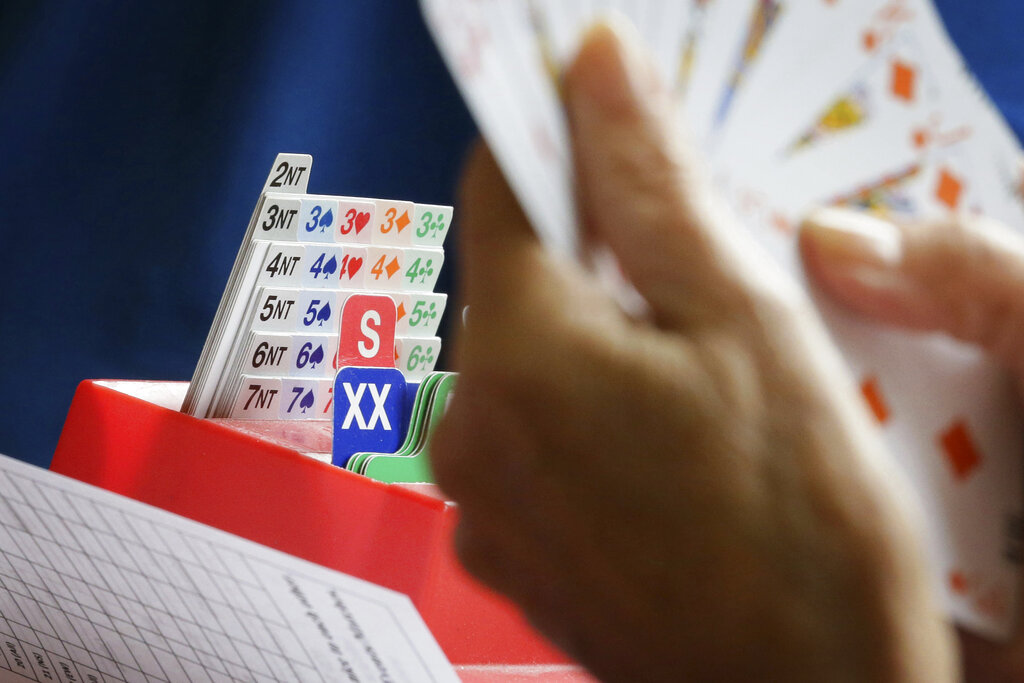
FILE – In this Tuesday Sept. 22, 2015 file picture, competitors play bridge at the Acol Bridge Club in West Hampstead, London. A doping ban handed down to the top-ranked player in bridge has provoked a backlash in the card game. It also has provoked criticism of bridge’s affiliation with the Olympics. (AP Photo/Tim Ireland, File)
PARIS— When the top-ranked bridge player tested positive for a steroid that Lance Armstrong also used to cheat at the Tour de France, it was easy to snigger. Juicing in cards? Ha! But within the card game recognized as a sport by the International Olympic Committee, fans and players seethed.
Whereas the eventual unmasking of Armstrong as a cycling swindler was widely hailed as a resounding victory for sports’ fight against doping, critics in bridge saw the positive drug test for Geir Helgemo as a black mark for the anti-doping system and proof that it shouldn’t be applied uniformly across sports.
“People think it’s wrong,” Boye Brogeland, a bridge professional who won two world championships with Helgemo, said of the top-ranked player’s test for the steroid testosterone and infertility drug clomifene.
“Nobody thinks he took this to get an edge at bridge,” Brogeland said in a phone interview.
Even the governing World Bridge Federation that punished 49-year-old Helgemo last month by banning the Norwegian for one year from lucrative professional competitions says most of the drugs and doping methods that are prohibited in bridge because the game has signed up to World Anti-Doping Agency rules don’t, in fact, make bridge players better.
Testosterone and clomifene, both found in the sample Helgemo provided last Sept. 29 at a World Bridge Series tournament in Orlando, Florida, are among the groups of substances that the WBF says in its anti-doping handbook for players are “not expected to affect performance in bridge.”
Yet the WBF prohibits and tests sporadically for them anyway, not because of any suspicion that their use is rife in the game but because that is the price the federation must pay to come under the Olympic umbrella. Accepting the WADA code and the jurisdiction of sports’ highest tribunal, the Court of Arbitration for Sport, are conditions for recognition by the IOC. IOC recognition , in turn, helps secure status and funding for bridge as it fights to stay relevant in the videogame era. It also allows WBF executives to cling to the so-far fruitless ambition of one day seeing bridge played at the Olympic Games.
On bridge forums, Helgemo’s case has provoked vigorous debate and a backlash , with critics questioning bridge’s adherence to WADA rules and its Olympic affiliation. For them, further proof that being part of the IOC system does more harm than good to bridge was a CAS ruling last year that dealt a blow to the game’s efforts to weed out cheating at cards. The Swiss court overturned five-year bans that bridge authorities had handed down for cheating to top players Fulvio Fantoni and Claudio Nunes. The CAS didn’t completely absolve the pair but ruled that the European Bridge League failed to prove that the players used a prearranged code during games to secretly tip each other off about their hands.
“The integrity of the game is lost because we are trying to get into Olympics,” Brogeland says. “The price is just too high. You cannot actually take the real cheats out of the game because of the Olympics, and now you actually take people out of the game who are not cheats.”
Helgemo’s case also reflects badly on the global anti-doping system, because it highlighted how unevenly WADA rules are applied across sports.
Unlike the vast majority of sports, which test athletes both when they’re competing and when they’re not, the bridge federation only tests players at major competitions.
And the WBF’s in-competition testing is extremely limited: Just 11 tests in total in 2017, the most recent year for which figures are available, and 14 in 2016.
“We simply don’t have the people to manage,” says Jaap Stomphorst, who heads a WBF anti-doping sub-committee. “At major competitions we test around 10-12 players, that’s all.”
That Helgemo escaped with a one-year ban also underscored how anti-doping punishments are unevenly applied across sports. He appears to have been leniently treated in comparison with athletes in active sports. The U.S. Anti-Doping Agency, for example, last year handed a 3-year ban to an amateur cyclist, Dylan Lima, only for testosterone and 1-year bans only for clomifene to two MMA fighters. For performance enhancers like testosterone, the WADA code calls for four-year bans when athletes fail to prove that they didn’t intentionally dope.
David Harris, the WBF counsel who prosecuted Helgemo’s case before a federation disciplinary panel, says the player “was unable to give a definitive explanation” of how testosterone and clomifene entered his body. Helgemo first suggested that he may have taken pills meant for his girlfriend before later blaming food supplements given to him by a friend, Harris said in a phone interview.
“The panel probably erred on the side of leniency,” he said. “They took into account the whole circumstances relating to the situation and came up with a decision that one year was the appropriate period of suspension.”
Helgemo didn’t respond to Associated Press efforts to reach him by email and text message. Harris said the Norwegian is currently serving a six-month prison sentence for tax offenses in Norway that is unconnected to his doping ban.
He said that as a top professional, Helgemo had been tested before, should have been aware of the anti-doping rules and should have been more careful.
“This was an unfortunate case, but it was a careless case in many ways,” Harris said. “This is a person who is earning a considerable amount of money out of playing bridge.”

